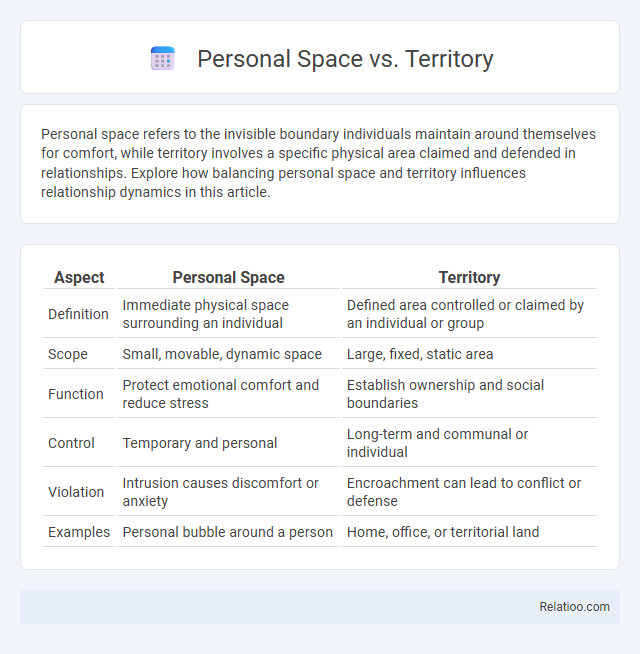Personal space refers to the invisible boundary individuals maintain around themselves for comfort, while territory involves a specific physical area claimed and defended in relationships. Explore how balancing personal space and territory influences relationship dynamics in this article.
Table of Comparison
| Aspect | Personal Space | Territory |
|---|---|---|
| Definition | Immediate physical space surrounding an individual | Defined area controlled or claimed by an individual or group |
| Scope | Small, movable, dynamic space | Large, fixed, static area |
| Function | Protect emotional comfort and reduce stress | Establish ownership and social boundaries |
| Control | Temporary and personal | Long-term and communal or individual |
| Violation | Intrusion causes discomfort or anxiety | Encroachment can lead to conflict or defense |
| Examples | Personal bubble around a person | Home, office, or territorial land |
Understanding Personal Space
Understanding personal space involves recognizing the invisible boundary individuals maintain to feel comfortable and secure in social interactions. Unlike territory, which refers to a physical area controlled by an individual or group, personal space is about the psychological comfort zone surrounding a person. Respecting your personal space and others' boundaries enhances communication and reduces anxiety in both personal and professional settings.
Defining Territory in Human Context
Territory in the human context refers to a physical or symbolic area that individuals or groups claim and defend to assert ownership or control, often marked by boundaries or personalized elements. It differs from personal space, which is the immediate, invisible buffer zone surrounding a person that protects their comfort during social interactions. Understanding human territory involves examining social, cultural, and psychological factors that influence how spaces are created, maintained, and respected in different environments.
Psychological Foundations of Personal Space
Personal space is the invisible boundary surrounding an individual, protecting psychological comfort and influencing social interactions, while territory refers to a physical area claimed and defended by a person or group. Personal preferences shape how much proximity feels comfortable, varying by culture, personality, and context, impacting emotional well-being and stress levels. Understanding these psychological foundations helps you navigate social environments respectfully and maintain positive relationships.
Territorial Behavior: Origins and Functions
Territorial behavior originates from evolutionary instincts aimed at securing resources, mating opportunities, and safety within a specified physical area. It functions to establish clear boundaries that reduce conflict and competition among individuals or groups, reinforcing social hierarchies and facilitating resource management. This behavior is observed across various species, including humans, where it manifests in both physical territory markers and psychological claims to space.
Personal Space vs. Territory: Key Differences
Personal space refers to the invisible boundary individuals maintain around themselves to feel comfortable and secure, typically extending a few feet depending on cultural and situational factors. Territory involves a fixed physical area that a person or group claims or defends, such as a home, office, or seating area, often marked clearly to signal ownership or control. The key difference lies in personal space being an invisible, mobile buffer zone around a person, while territory is a tangible, stationary physical space associated with ownership or control.
Cultural Variations in Personal Space and Territory
Cultural variations significantly influence perceptions of personal space and territory, with proxemic behavior differing widely across societies. For instance, Latin American and Middle Eastern cultures often tolerate closer interpersonal distances, while Northern European and East Asian cultures prefer more expansive personal zones. These differences impact social interactions, territorial boundaries, and individual comfort, shaping communication norms and spatial preferences globally.
Personal Boundaries in Social Interactions
Personal boundaries in social interactions define the invisible lines that protect your personal space and emotional comfort. Unlike territory, which refers to a physical area you control, personal space is an immediate buffer zone that varies by culture and individual preference. Respect for these boundaries ensures healthier communication and mutual respect in social settings.
Impact of Technology on Personal and Territorial Spaces
Technology profoundly reshapes personal and territorial spaces by enabling constant connectivity through smartphones and social media, blurring boundaries between private and public zones. Digital platforms extend personal preferences into virtual environments, allowing individuals to customize their spatial experiences, while smart home devices redefine territorial control, automating and monitoring physical spaces. This convergence of technology alters traditional concepts of personal space and territory, influencing social interactions and privacy expectations in increasingly complex ways.
Violations: Consequences of Overstepping Boundaries
Violations of personal space, territory, and preferences trigger psychological stress, anxiety, and in some cases, aggressive behavior due to the perceived threat to individual autonomy. Overstepping boundaries often leads to deteriorated trust, strained relationships, and reduced productivity in personal and professional environments. Recognizing and respecting these boundaries is essential for maintaining social harmony and emotional well-being.
Strategies for Respecting Personal Space and Territory
Strategies for respecting personal space and territory involve recognizing individual boundaries and adapting your behavior accordingly. Maintain an appropriate physical distance based on cultural and situational context to honor someone's personal space while avoiding intrusion into their territory, such as their home or workspace. You can also observe nonverbal cues and ask for consent when approaching unfamiliar areas or individuals to ensure comfort and mutual respect.

Infographic: Personal space vs Territory
 relatioo.com
relatioo.com